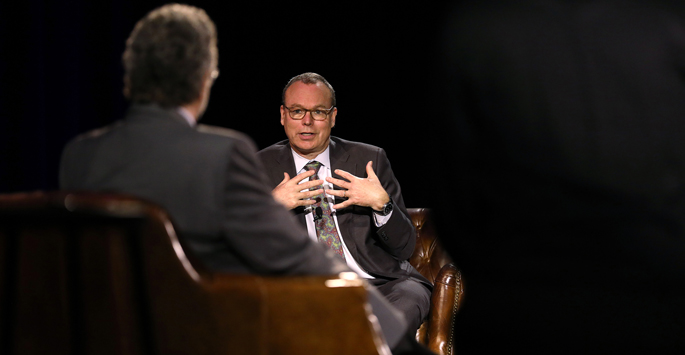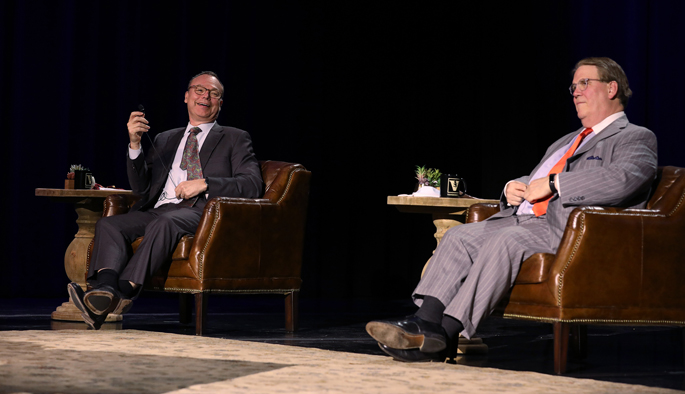
by Holly Fletcher
During a first-ever virtual leadership assembly necessitated through social distancing, Vanderbilt University Medical Center leaders answered questions about the Medical Center’s response to COVID-19 so far and what the future could hold.
The last two months have publicly showcased VUMC’s leadership role in the community’s response to the pandemic while thrusting individuals and research teams onto the national and international stage through their deep understanding of coronaviruses and the advancements that are driving toward treatments and vaccines.
The resolve and innovation on display over the past two months spotlight VUMC’s caring spirit — and underscore how that spirit is fundamental to all Medical Center missions, said Jeff Balser, MD, PhD, President and CEO of VUMC and Dean of Vanderbilt University School of Medicine.
“If you look at all the individual things that happened, you see this is a Medical Center where people are passionate about the things they do, but you also see that we’re wired for making things better. Our people come to work every day to do exceptional work, and at the same time are constantly thinking about how it could be done better. When this pandemic hit, all that capacity for innovation just went full throttle,” said Balser.
Balser and C. Wright Pinson, MBA, MD, Deputy CEO and Chief Health System Officer, sat with veteran journalist John Seigenthaler Jr. for a conversation about how real-time pivots and innovation across VUMC made the pandemic response robust while becoming a beacon of hope in an era defined by anxiety and uncertainty.
Innovation
Teams cooperated to get VUMC’s hospitals and clinics ready to meet the potential demands from COVID-19. Innovation across teams from a vast array of areas, including but not limited to Access Services, Outpatient Services, Legal Affairs, Finance, Telehealth Services, VUMC IT and the Department of Biomedical Informatics, along with creative assistance from medical students who helped sign up patients, led to explosive growth in telehealth services. The telehealth innovation is representative of change that happened across the organization in other areas as many were cross-trained or adapted to new roles to fulfill newly recognized needs.
Valets quickly became screeners at building entrances, and in a week, there was a HIPAA-compliant process that could be used for telehealth via My Health at Vanderbilt.
“Those successes are inspiring amidst what has been a tragedy for many, many people,” said Balser.

The get-it-done attitude highlighted the resilient nature of the staff as they transitioned either to work-from-home arrangements or new responsibilities, said Pinson. The enterprise’s planning started well before the first COVID cases emerged in Seattle, and VUMC’s experts began coordinating with local and state officials to share information and help shape plans. Internally, teams worked to ensure adequate supplies of PPE would be on hand while others addressed COVID-specific communications needs, the logistics of cross training staff and increased efforts to recruit new nurses to strengthen the labor pool, he said.
“We did not want to leave our front-line workers in a bad place. We were eager to make available the equipment and supplies they would need for the duration. The daily communications and website — those were our source of truth and a great strength. It was all the pieces of the plan put together,” Pinson said.
In addition to leading the way on antiviral and antibody research and treatments, the Medical Center is actively learning from the COVID-19 response how to improve treatment and access for patients as well as develop a more comprehensive system for all who need it, particularly for immigrants and those who are often overlooked in traditional settings.
“We are building new muscles as we’ve had to gather data and make decisions in real-time. We’ve been living in a sea of ambiguity, but looking over the last several weeks, the way people responded with knowledge and informed instincts should make them really proud. There’s a confidence that people are building as we experience this, and that reinforces the ‘caring spirit’ that’s a very special feature of this Medical Center,” Balser said.
Finances
VUMC has so far been able to avoid furloughs and pay cuts that other health systems across the country have implemented. Medical Center leaders did not want to add an extra burden on staff by reducing pay — a circumstance that was already hitting many households — and opted to find tradeoffs down the road so people on the front line are supported.
“We said, ‘Let’s take care of these folks so they can take care of all of us.’ It’s because we just feel those really fighting it on the front line — the last thing they need is to be also dealing with stress that we impose here at VUMC,” he said.
Balser noted that projects already underway for growth across the region are proceeding but other programs or building plans could be delayed until volume and income are at relatively normal levels.
“If we have a tradeoff, I’d rather tradeoff those things and keep everyone working and well,” he said.
Future
According to Pinson, how well people physically distance themselves and how seriously they follow guidelines designed to reduce spread of COVID-19 will determine the trajectory of the disease in the region and state.
“We’re just uncertain what this will look like, but we know it’s time to open back up. The watchword is ‘safely,’” Pinson said. “Everybody at a personal level has a certain amount of anxiety and fear and displeasure about the uncertainty of these circumstances. What we have attempted to do is replace that with plans, actions and confidence. I believe we can help people have confidence and belief that the future will be OK.”
Balser said many believe a vaccine will be available in the next year to 18 months, and that he likes to think about the work being done at VUMC — and with industry and commercial partners — as the bridge to get people to the vaccine.
The next two months will be as full of change as the last two, which went from feeling like “full frontal assault” to phases of recovery, Balser said. But VUMC’s resilience and innovative capacity — from telehealth to launching one of the earliest lab-developed COVID-19 tests to finding ways to work from home — demonstrates the Medical Center’s ability to keep finding ways to not only subsist, but to thrive.
“What so many people and the entire country have gone through is grief. Our people have lost people close to them and have children and spouses without jobs. But I believe that even as we experience the phases of grief, ultimately our story is one of hope,” he said.












